6/27/2013
Color, Up and Down the Coast
Chris Beytes, Ellen C. Wells & Jennifer Zurko
Some said that the 2013 edition of the California Spring Trials was a good argument for going to an every-other-year schedule—implying that there just wasn’t that much new or exciting to be found. But we’d say that those folks are: 1) very hard to please; 2) have very high expectations; 3) skipped some key trials; or 4) just weren’t looking closely enough. Because by our count, there were 1,250 new or improved plant varieties introduced by the 50-plus plant companies exhibiting this year—plenty to fill your greenhouse or garden center for the next season or two.
Yes, there were plenty of me-toos—there always are. Nothing wrong with that; no breeder wants to be left out of a hot category like coleus, euphorbia or geranium. And granted, there was no genetic breakthrough that had everybody talking—no calibrachoa from seed or blue zonal geranium (although the world’s first F1 seed canna is worth mentioning).
There were a few other items we’d never seen before, such as a giant-flowered gomphrena and a digitalis/
isoplexis cross. But these, while novel, fun and worth trying, aren’t going to set the gardening world on fire.
In our judgment, great colors were the main story of 2013. It was the colorful stuff that was most memorable and got attendees most excited. But color is just a portion of what’s worth writing about. On the following pages of GrowerTalks and Green Profit, we’ll cover the key introductions, new series, products growers will love, varieties suited for grower/retailers (generally, crops you don’t want to have to stuff onto a shipping cart), new petunias (the hot category for 2013), combos, earth-friendly products and more.
Next month, we’ll cover perennials, pot crops and anything we missed this time.
Key Intros
If a Spring Trials trial attendee can remember a variety five days and 1,250 introductions later, it’s key. An addition to an already-important series is key. An eye-popping new color or pattern is key. An All-America Selections award is key. These introductions fit those descriptions.
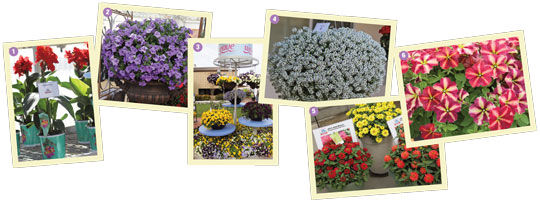 1. F1 Canna South Pacific Scarlet (American Takii)
1. F1 Canna South Pacific Scarlet (American Takii) American Takii has led the seed canna market with its venerable open-pollinated Tropical series. Now, they up the ante with the world’s first F1 canna, South Pacific. Big and bold, as you’d expect a hybrid to be. Seed cannas are important because seed doesn’t harbor or transmit the viruses to which cannas are prone. South Pacific starts with Scarlet; we can only hope more colors are in the back room. Oh, it’s an AAS winner, too, another sign of a key intro.
2. Surfinia Heavenly Blue (Suntory) Said to be the “next generation” of Surfinia, Heavenly Blue is an improvement over (but not a replacement for) Surfinia Sky Blue. Deeper color, more compact habit. (Purple Majesty is another Surfinia color addition.)
3. Pansy Cool Wave color additions (PanAmerican Seed) One of last year’s key introductions, Cool Wave started a new category of spreading/trailing pansies. For 2014, the series gets two essential colors—Purple and Golden Yellow—along with two new designer mixes (Pastel Mix and Berries ’N Cream Mix).
4. Lobularia White Night (Proven Winners) Before Snow Princess, everybody called lobularia alyssum (the genus under which it was classified). Now this popular-but-unruly vegetative sweet alyssum gets a little brother, White Knight, which is less vigorous and much more manageable in mixed containers. You grow it with the same regime as Snow Princess, but it reaches just half her size at maturity.
5. Zinnia Profusion Doubles color additions (Sakata) An easy one to promote because two of the three new Profusion Doubles—Double Deep Salmon and Double Hot Cherry—are AAS winners. (Double Yellow wasn’t entered or it might have won, too!) Plus, three of the existing singles are also AAS winners. Some pedigree! ’Nuff said.
6. Petunia Cha-ching Cherry (Ball FloraPlant) We name this a key intro for its striking pattern and color, which blends a cherry-red star, with a cream and yellow star pattern. Definitely an endcap plant—feature it in a display next spring all by itself and watch it fly. A sister variety, Rose and Shine, is also eye-catching.
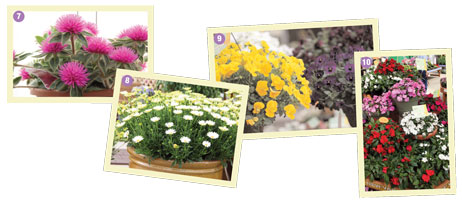 7. Gomphrena Pink Zazzle (EuroAmerican Propagators)
7. Gomphrena Pink Zazzle (EuroAmerican Propagators) We label it key because this unusual gomphrena caused more buzz than just about any intro, due to its funky flowers and even funkier name. But it’ll be a challenge to grow except in hot, dry climates.
8. Osteospermum White Lightening (Burpee Home Gardens) Sometimes a stand-alone variety takes the world by storm, and that’s what happened with Osteo Voltage Yellow. As you might guess by its name, White Lightening is the white-flowered sister to Voltage Yellow.
9. Pansy WonderFall color additions (Syngenta) Launched last year as a Cool Wave competitor with six novelty colors, WonderFall gets five important core colors for 2014: Violet, Yellow (pictured), White, Yellow with Blotch and Blue with Blotch (pictured). Syngenta says WonderFall stands out for its broad color range, larger (by 20%) flowers and bigger, beefier plants. Oh, POP is available, too.
10. New Guinea Impatiens Florific (Syngenta) Key because it’s only the second seed-propagated New Guinea on the market, and because the industry needs good low-cost shade alternatives to I. walleriana. The series starts with four colors.
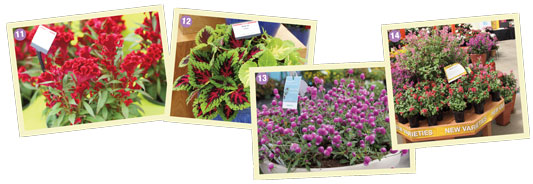 11. Celosia Twisted (Ball Ingenuity)
11. Celosia Twisted (Ball Ingenuity) This cristata (cockscomb) type joins Celosia Intenz in the category of weird-but-wonderful varieties that can serve as pot or garden plants. Flowers are vivid red with hints of fuchsia and orange. This vegetative annual needs no blackclothing to bloom for spring, either.
12. Coleus Kong Jr. (Ball Ingenuity) This introduction is a bit of an oxymoron—after all, we love Kong Coleus for its size. Why a junior version? To get those same nice Kong color patterns on a plant that’s the same size, but with leaves that are 30% smaller. That’s good for mass-market distribution (less damage), smaller pots and mixed combos that a regular Kong might dominate.
13. Gomphrena Pinball (Sakata) This vegetative gomphrena got everyone excited for its potential to add a unique flower form and texture to combinations. Being vegetative, it’s sterile, floriferous and mounded. Three colors: Purple (pictured), White and Snow Tip Lavender.
14. Cuphea Sriracha (Syngenta) Trial visitors immediately recognized the iconic bottles of the Thai hot sauce Sriracha (the first R is silent). Putting two and two together, Cuphea Sriracha must be a heat-lover. And it is. You grow it just like a vinca. But most noticeable is its really big flowers (big for a cuphea, anyway). The series starts with three colors: Pink, Rose and Violet.
New Series
Arguably the most important category, since it shows where breeders have invested most heavily. And it may reveal trends in a crop category: Is a variety getting more heat tolerant? More compact? More trailing? First from seed? First from cuttings? Here’s just a small sampling of what was new in full series.
 1. Diascia Sundiascia (Suntory)
1. Diascia Sundiascia (Suntory) One of Suntory’s four new series for 2014, their first diascia features a very upright habit. Deep green foliage sets off the three flower colors nicely. The series starts with Upright Blush Pink, Upright Rose Pink and Upright Orange. One production note: longer days yield longer flower spikes.
2. Calibrachoa Earlybird (Westhoff) This series is naturally dwarf, requiring no PGRs to achieve a tight, compact habit. As the name implies, the series is daylength neutral for early flowering. They compare to Calipetite. Six candy-like colors.
3. Dahlia Dahlinova Temptation (Fides) A subseries, really, of the popular Dahlinova Dahlia series, featuring dark-leafed foliage and dark stems. Five colors that really pop against the dark foliage.
4. Angelonia Statuesque (Hort Couture) Another introduction whose name neatly describes the habit: upright and tall (the supermodel image fits nicely with their fashion theme, too). Statuesque grows to about 18 in. and starts with three colors: Blue, Pink and White.
5. Trailing Snapdragon Candy Shower (Sakata) The first trailing snap from seed got a soft launch last year and makes a full introduction for 2014. Why is it superior to a vegetative trailing snap? Sakata pelletizes the seed, with each pellet having five to seven seeds. So, if you plant three plugs in a basket, you have 15 to 20 plants for a lush, full product.
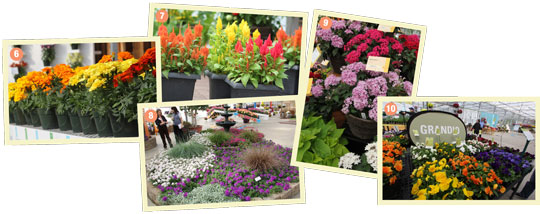 6. Marigold Cresta series, Alumia series (Floranova)
6. Marigold Cresta series, Alumia series (Floranova) Not one, but two, new French marigold series from this English breeder. Cresta has crested flowers and compares to Bonanza and Hero. Seven colors. Alumia, with five colors, has anemone flowers and compares to Durango and Safari. Both series are said to be up to a week earlier than the competition (Durango, Safari). Open pollinated, from seed.
7. Celosia First Flame (PanAmerican Seed) First Flame’s claim to fame? Earliness (“First,” get it?). PAS says it’s a week earlier than Fresh Look, but otherwise has similar container and garden habit. The series starts with three colors.
8. Verbena Enduro (Ball FloraPlant) A key introduction for Ball FloraPlant this year, Enduro takes its name from the dual-purpose on-road/off-road motorcycle. Enduro verbena’s dual purpose? It takes the heat, staying in color all summer; and it will tolerate low temperatures down to the teens. BFP likens it to an improved Homestead Purple. The series starts with Rose, White Blush and Purple.
9. Pentas Starcluster (Syngenta) This vegetative pentas is a tetraploid, meaning big flowers, strong stems and great landscape performance, especially in the south. But it needs big pots—gallon-size or larger. The series features Red, Rose, Lavender and White.
10. Pansy Grandio (Sakata) Sakata, long a leader in the pansy market, ups their game with a new Delta fighter called Grandio. This large-flowered series has been bred for spring or fall production and bench runs, thanks to its three to four-day bloom window. Starts with six clear and four blotch colors, plus five designer mixes.
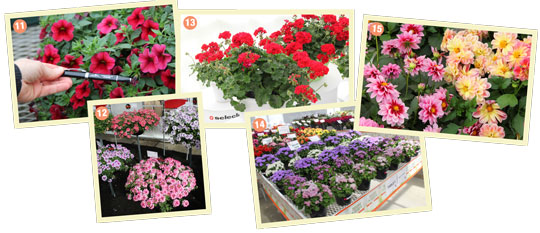 11. Calibrachoa Cruze (Green Fuse Botanicals)
11. Calibrachoa Cruze (Green Fuse Botanicals) The goal with Cruze was the largest flowers possible while retaining the mounded habit growers and consumers both like. Flowers are over 2 in. in diameter, with some nice eye types. Seven colors in the series.
12. Verbena Wicked (Dümmen) This new verbena series features nothing but bicolors: Blue, Hot Pink, Purple and Pink Pepper.
13. Geranium Double Take (Selecta) Selecta has gotten into the interspecific geranium (ivy/zonal cross) market made hot by Calliope and Caliente with their own new series, Double Take. Its claim to fame? Less shattering of the flowers. They even showed it off on a bucking bronco-style display stand. Red, Scarlet, Pink, Pink+Eye and White.
14. Ageratum Ariella (Cohen) One of the few vegetative ageratum series on the market, Ariella gets four colors: Rose, White, Violet, Blue and Power Blue (“power” indicating a more vigorous subseries).
15. Dahlia Dalaya (Selecta) Striking colors mark this new dahlia series, which starts with two multi-color flowers: Shari (sort of a tequila sunrise color) and Yogi (bicolor pink with a yellow center). Shari is a type of Indian fabric. The inspiration for the series and color names? The breeder is Indian.
 16. Viola Bel Viso (Floranova)
16. Viola Bel Viso (Floranova) Bel Viso means “pretty face” on this F1 viola series that they’re positioning against Penny and Sorbet. Bel Viso starts with 13 standard and novel colors (there are some cool experimentals in the back room). 90% germination.
17. Ivy Geranium Focus (Ball FloraPlant) This compact upright series is designed for quart pots, says Ball FloraPlant. And if offers good heat performance. Dark green foliage sets off the four colors: Rose, Burgundy, Red Ice and Hot Pink.
18. Sunbelia Lobelia (Suntory) Suntory’s first lobelia is compact and great for 4-in. pots, they say, with good heat and sun tolerance. The series starts with three colors: Compact Pink, Compact Sky Blue (pictured) and Compact White.
19. Coleus Mainstreet (Dümmen) Yes, there are plenty of coleus on the market … and now Dümmen has a series, too. Eight colors, each named for a famous street (such as Wall Street, Abbey Road and Fifth Avenue). From the University of Florida breeding program. One bonus to having a coleus series: They can add coleus to their Confetti multi-variety liners.
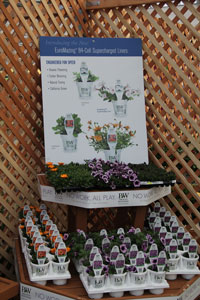 Just for Growers
Just for Growers
Breeders have been busy coming up with new ways to help growers be more successful by ensuring
higher-quality plants during the vital production period before it even gets to the customers’ door.
Supercharged Liners (Pictured: left) (EuroAmerican Propagators) EuroAmerican has done all of the work for you with this program of 84-ct. liners that have already been pinched and treated with PGRs. Not only do you get a stronger, faster, better plant, but you save two weeks off of the finished time.
Fuseables Precision Multi-Seed Pellet (PanAmerican Seed) In a brand new breakthrough technology that’s an upgrade to the Fuseables line of multi-seed pellets, they’ve figured out a way to more accurately create pellets to put a precise number of each variety or color in each pellet.
Cutting Time Callused Program (Syngenta) The whole idea behind this new vegetative program is to cut time off of the rooting process by two to three weeks. It includes the commonly offered varieties that come as callused cuttings—like geraniums and poinsettias—but also seven other classes that have longer crop times, like dipladenia, gaillardia, heliotrope and scaevola. Syngenta’s Liz Hunt said that it’s a premium item, meaning it costs a bit more than regular unrooted cuttings, but it’s also a high-value product.
Marengo Pre-Emergent Herbicide (OHP) For those of you who have hoop houses, weed control can sometimes be a problem, but OHP has introduced a new pre-emergent herbicide to help you with that. Specially designed for open houses where you grow cool-season plants and for when you just plain don’t have the time to get out there to get rid of the weeds, Marengo offers control for six to eight months. Dave Barcel said that 14.5 fl. oz. of Marengo covers one acre. He also said that they’re working on a granular form of Marengo, which is only offered as a liquid right now.
Augeo on Knock Out Roses (OHP) Dave and his team also showed some new trials they’re doing with OHP’s Augeo PGR on Knock Out Roses. To see Dave explain it himself, visit http://tinyurl.com/augeoroses.
Petunias A-Plenty
Every year, there’s one class that has the most introductions and this time it was petunias.
 1. Flash Mob (Burpee Home Gardens)
1. Flash Mob (Burpee Home Gardens) Two colors make up this new series, Bluerific and Redtastic, which is similar to morn-type colors with a trailing, mounded habit.
2. Damask (Syngenta) No PGRs are needed for this new multiflora series, they say, that includes eight colors. Ideal for high-density production in packs, they’re easy to ship and are low maintenance in the garden.
3. Espresso and Espresso Grande (Floranova) The UK breeder was giving out espresso mugs to celebrate these two new petunia series. Espresso is the multiflora type and Espresso Grande (Pink is pictured) is grandiflora with huge flowers. Both series bounce back quickly from rain and make beautiful baskets without stretching.
4. Blanket Double Zinfandel and Double Chardonnay (GreenFuse Botanicals) GreenFuse’s Steve Jones told us that Double Chardonnay (pictured) is the best double petunia he’s ever seen because the plant is covered with flowers, hiding the spent blooms underneath the canopy and leave it looking tidy.
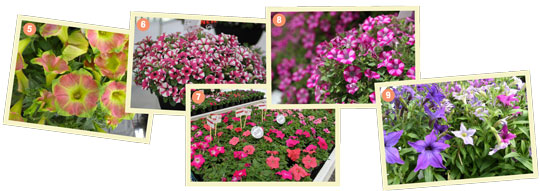 5. Crazytunias (Westhoff)
5. Crazytunias (Westhoff) We got a sneak peek of these last year, but were sworn to secrecy. Luckily this year, we can spill the beans about this collection (not a series) of petunias. Black Mamba and Terracotta were standouts, along with two of their subseries: Twilight and Kermit—which of course has a bicolor one named Piggy (pictured).
6. Potunias, Sweetunias and Surprise (Dümmen) Dümmen had a lot of new additions to their three popular petunia lines. For Potunias, you now have Piccola Blue, Pink Ice, Plus Soft Pink and Plus Cobalt Blue. (“Plus” being 20% to 25% more vigorous than regular Potunias.) Sweetunias (medium, upright vigor) have new colors like Grape Ice, Johnny Flame and Pink Lemonade. And the Surprise series (spreading, patterned flowers) is welcoming new Grape and Peppy (pictured).
7. Limbo and Mambo (Hem Genetics) The story here is the “GP” that Hem is starting to put on many of their classes, GP meaning “Garden Performance.” They’re slowly making improvements on all of the colors in their Limbo grandiflora and Mambo multiflora series to grow better in consumers’ gardens. New for 2014 is Limbo Plum and Mambo Pink, Mambo Salmon and Mambo Peach. And, like the rest of the series, none of them require PGRs.
8. Mini Blast Rose (Sakata) The first one in what will be a series coming soon, this variety features a tri-color pattern with a mounding habit. It’s also early to flower with good heat tolerance.
9. Sparkler (Thompson & Morgan) An open-pollinated hybrid, the blooms on this variety are star shaped and come in a mix of colors of purple, pink and lavender. Andrew Spencer said that this one has received a lot
of attention from their grower customers.
Combo Craze
Combination recipes and multi-variety liner programs continue to be popular with retailers and home gardeners, so every year, breeders are creating new mixes for both color and function. Even new players are joining the game — like Trifecta (EuroAmerican Propagators), Passion Combos (Westhoff), One Touch (Benary) and Think Outside the Pack (PanAmerican Seed).
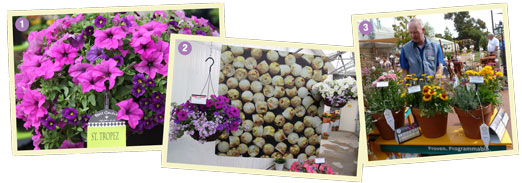 1. Cities of Fashion (Hort Couture)
1. Cities of Fashion (Hort Couture) They showed four of about a half dozen new combinations named after fashionable cities around the world, like St. Tropez (pictured), Florence and Palm Springs.
2. Fuseables (PanAmerican Seed) Three new mixes are available in the new upgraded Fuseables Precision Multi-Seed Pellet: Healing Waters, Strawberry Wine and Sunny Day.
3. Perennial Combos from Seed (Kieft) The seed perennials breeder introduced this new program with 13 mixes, all with first-year flowering perennials.
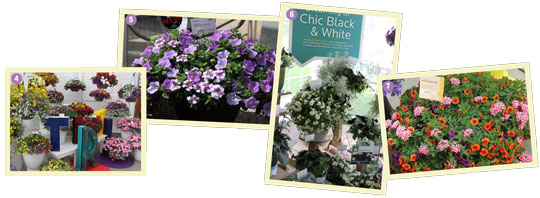 4. Trixi (Selecta)
4. Trixi (Selecta) New for 2014 are three improved mixes and two new ones—Fashion and Blue Fashion.
5. Confetti Gardens (Dümmen) The program now boasts more than 50 combos, with 11 new ones, including Fleur de Edna and Shocking Blue (pictured).
6. Combos from the HGTV HOME Plant Collection They had lots of new combos with each encompassing its own theme with fun names like Friendly Fusions, Sassy Sweethearts, Big & Bold (for REALLY BIG premium containers) and Chic Black & White (that capitalizes on a current color trend).
7. Kwik Kombos (Syngenta) Along with new POP, this program has nine new mixes that were all trialed and surveyed by growers and consumers, who didn’t agree on their favorites, which we found interesting. The growers like the new Plum-tastic and consumers chose Summer Skyline (pictured).
Earth-Friendly Fare
Organic products are still top-of-mind for many consumers and these programs give growers tools to offer sustainable plant programs.
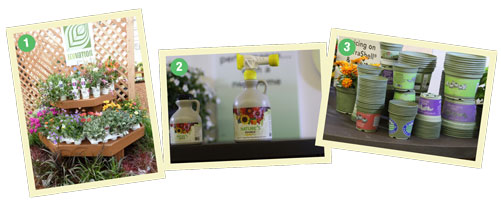 1. Ecovation (EuroAmerican Propagators)
1. Ecovation (EuroAmerican Propagators) A collection of drought-tolerant plants that combines well with succulents and saves growers on inputs.
2. Nature’s Source (Ball DPF) Formerly known as Daniels and recently earning OMRI approval for organic production, it’s the same plant-based formula with a name that’s more clear about what the product’s about. A new sprayer and plant food packets are new for the retail market, too.
3. Terra Shell (Ball Innovations) Made from vegetable starches, this compostable line of pots comes in 4 in. and 6 in. from Summit and you can have any brand logo and/or plant information printed on it. Ball’s Drew Effron said that they’ve reduced the price by 20% from last year, which is comparable to regular branded plastic pots.
A Plant By Any Other Name …
One of the (many) fun parts of Spring Trials is seeing how creative the marketing folks have been in naming new varieties. One trend that kept popping up were names with the letter Z. (Zurko can’t always be the solo “Z” on this trip, you know …)
Pink Zazzle (Gomphrena from EuroAmerican Propagators)
Zinfandel (Double petunia from GreenFuse Botanicals)
Pizzazz (Sedum from PlantHaven)
Pink Fizz (Dianthus from PlantHaven)
CranRazz (Buddleia from Ball Ornamentals)
Sundaze Blaze (Bracteantha from Proven Winners)
Of course, there were other unique and cool-sounding plant names we came across …
Piggy (Part of the Kermit subseries of Crazytunias from Westhoff)
Babycakes (Nemesia from Cultivaris)
Johnny Flame (Petunia from Dümmen)
Sugar Love (Experimental stevia from Hishtil)
Cat’s Meow (Nepeta from Proven Winners)
Tickle Pink (Petunia from Thompson & Morgan)
Cello Lemon Yellow (Pansy from Hem Genetics)
The Best of …
If we had awards for the best in these categories, here’s who would be taking home
the trophy:
Trial Book: Ball, Proven Winners and Syngenta—Ball and Proven Winners gave you a “notebook” where you could write notes. All of them offered something that was created specifically for Spring Trials with all of the new varieties instead of an entire catalog.
Lunch: 
Dümmen and Ball—Of course, we’re going to mention food! Both went above and beyond sandwiches and hamburgers with a delicious, eclectic menu. But Dümmen had a slight edge because they served wine with their meal.
Trial Location: Dümmen—Nothing beats the beauty of Edna Valley Vineyard. And did we mention the wine?
Displays: Pacific Plug & Liner—The retail vignettes designed by PP&L’s April Herring showcased their new varieties with brilliantly creative colors and props. We were blown away.
Swag: Benary—They were celebrating their new North American production facility in Watsonville by giving away bier steins (with German bier) and German cookies. Prost!
Taste Testing: ABZ Seeds and Hortus Group—In case you weren’t sure that the strawberries from ABZ Seeds and the Heartbreakers Tomatoes from Hortus Group were any good, don’t worry … we tried them (repeatedly) and they’re excellent.
GT